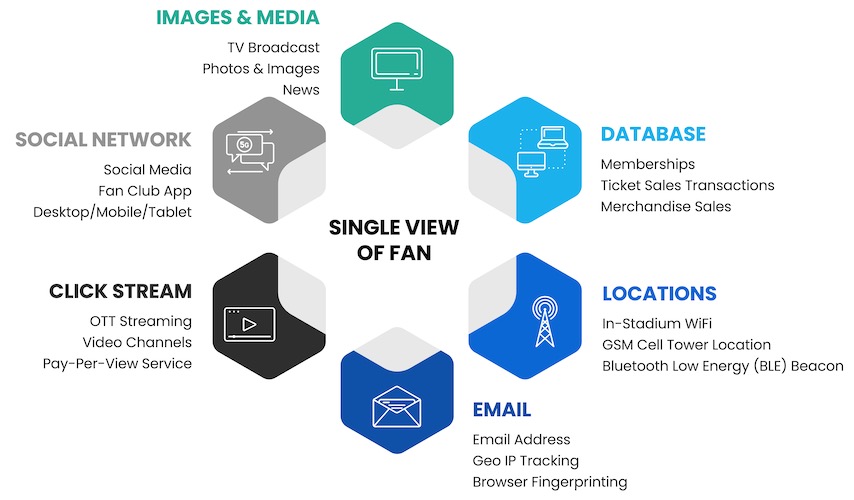Why Big Data empowers the Single View of the Fan

2022-04 Fuelled by large volumes of data created at increasing rates and derived from a variety of sources, Big Data enables a single view of the fan to foster quality engagement and produce insights. The sports world is now well and truly emerging back out of the Covid 19 pandemic. As with many industries around the world, the pandemic has left a lasting effect in many ways. The acceleration in digital transformation and adoption of innovation in different industries has been seen quite clearly and sports has not been exempt.
COVID accelerating the digital transformation
One of these innovations that have been pushed by the Covid 19 pandemics is the introductin of more fan engagement orientated and high-tech stadiums. During the pandemic, sports fans around the world were shut out of stadiums indefinitely and confined to watching sports from the comfort of their own living room. However, this created an environment for sports fans to change their viewing habits resulting in the emergence of the use of a second and even a third screen to interact with while watching games. Accordingly, the challenge for teams now coming out of this pandemic is, how to motivate these fans to come back into stadiums and satisfy this new habit of second-screening?
Entering the high-tech stadium
The smart stadium extends well beyond the field of play [1]. These new stadiums are equipped with a whole array of advancements that can help satisfy these new habits of the audience. Infrastructure facilities such as a good reliable internet connection are presumed these days and allow fans’ mobile phones to be an effective second screen within the stadium. Being connected during the game, allows fans to check player stats and live scores, while sharing their experience, and following the action on social media. Additionally, more advanced scoreboards and screens around the stadium can display unique advanced metrics and insights to further amplify the experience of this more connected fan base. But getting fans to leave the comfort of their home is also about convenience and advancements such as digital ticketing and contactless pay that were accelerated due to the pandemic will also play a role in this.
Big Data along the customer journey
However, this added level of connectivity for the fans also presents a whole new opportunity for the clubs and leagues. Using this newly available information it provides, can allow them to better understand their fans and gain a more holistic view of them. High-tech stadiums will be able to provide clubs and leagues with a plethora of data on their fans from geo-location information such as where fans go during the game as well as data on what content fans are accessing during the game and during what periods mobile phone usage goes up or down.
But the information clubs and leagues can gather about their fans is not just confined to the stadiums, instead, there are a whole number of avenues that can provide valuable data about a fan base. These opportunities to gain information present themselves all throughout the customer journey, extending also to pre- and post-game periods and are no longer just confined to the time in the stadium during the game [2].
From fragmented information to the single view of the fan
Places like social media have an abundance of available information for these leagues and clubs from the geographical location of fanbases, to the engagement rate with posts and how many new unique users are visiting and interacting with their content. Where traditional media was able to present information like how many people watched a TV broadcast or read a certain article about a player or a team, new media platforms such as the apps provided by the league and teams as well as third party independent content providers or aggregators can be used to collect more profound information. This is due to users being required to create an account and select their preferences in terms of what league and which teams they are interested in. Such customer insights also carry across to the streaming services that are now becoming the norm in how people fans watch sports at home. Then there's also information available from databases such as membership numbers and ticket sales that can let clubs and leagues know the relative size of their fanbases that are coming to the game and how these numbers fluctuate from game to gamer and season to season. Along with memberships comes the information and direct connection to the fans through their emails too.

Fig. Sources of Big Data empowering the single view of the fan
The accumulation of all this information and data is what builds and forms this single view of the fan, allowing the clubs and leagues to gain a deeper, more holistic understanding of their fan base and their tendencies. This in turn can assist these leagues and clubs in more effectively engaging with their audience, continuing to build their fan base, and growing their sport.
Additional Information
For further information contact chemneera.
References
[1] https://www.chemneera.com/news-and-resources/smart-stadium-extending-beyond-on-field-data
[2] Schlegel M.U., Hill C. (2020). The Reach of Sports Technologies. In: Schmidt S.L. (eds) 21st Century Sports. Future of Business and Finance. Springer, Cham. https://doi.org/10.1007/978-3-030-50801-2_6



